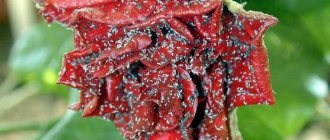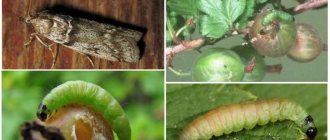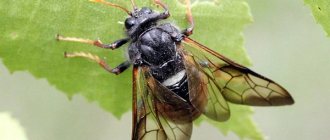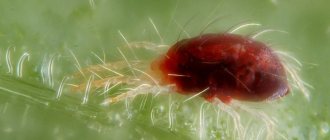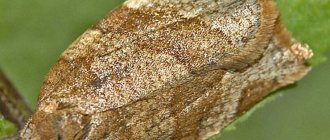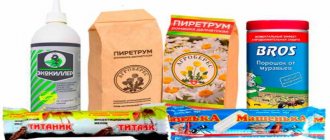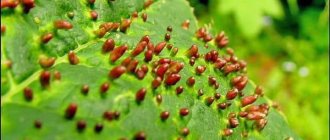Signs and characteristics of the pest
The leaf roller is a butterfly, but damage to trees is caused by its larvae, caterpillars. They appear from eggs that the butterfly lays on the crown of trees. Butterflies are active in the morning and evening. The degree of activity depends on climatic factors:
- importance;
- illumination;
- temperature.
Signs of damage to apple trees by leaf roller caterpillars depend on the period:
- In spring: young leaves, buds and flowers are covered with cobwebs and eaten.
- Late spring – early summer: the foliage is rolled into tubes or collected in bunches, cocoons are visible.
- End of summer: caterpillars move to the fruits, gnaw them, there is a thick cobweb on the foliage, there are many flying butterflies.
- Beginning of autumn: on the upper surface of the leaves there are dark spots with oviposition.
- Mid-autumn: foliage is rolled into tubes or collected in bunches, greenery has been eaten, there are a lot of cobwebs.
A massive pest invasion destroys more than 50% of the crop.
Description of the pest
There are a large number of leaf roller species. The main damage to the apple tree is caused by rosanna. The butterfly has the following characteristics:
size – up to 3 cm, resembles a moth;- wingspan – up to 30 mm;
- body with a dense covering of hairs;
- wings are gray or various shades of brown, with a pattern in the form of stripes or ornaments;
- The folding of the wings is horizontal.
The caterpillars look like this:
- green-yellow body with dots on the back, length - from 10 to 12 mm;
- there are hooks on the abdomen;
- 8 pairs of legs;
- the head is brown or black.
Geography of distribution
The leaf roller is common on all continents except Antarctica. There are 2,500 known species in the Russian Federation, the most dangerous are 100 species. Seen in large numbers:
- in mixed and deciduous forests of the northern hemisphere;
- in subtropical and tropical forests of Asia.
Reproduction is bisexual.
Stages of development
The stage of development is determined by the species. The leaf roller appears in April-May and goes through the life cycle:
- Mates 2–3 days after emerging from the pupa:
- in the spring after fertilization, lays up to 150 eggs up to 1 mm in size per clutch on leaves, on the bark of trees and branches;
- eggs overwinter on a tree;
- in the spring, caterpillars emerge from the eggs and eat buds, leaves, and fruits;
- in summer the larvae pupate;
- after 2 weeks the adult insect flies out;
- Mates and lays new eggs.
Second generation caterpillars born in late summer:
- in the fall they prepare a cocoon from a spider's web for wintering;
- overwinter in a cocoon on branches;
- in early spring they switch to young buds and leaves;
- continue nutrition and development.
Under favorable conditions, the pest produces several generations of caterpillars.
In early spring, it is necessary to inspect fruit crops to identify caterpillars.
General information and insect damage
The pear leaf roller aphid belongs to a group of insects with more than 10,000 species. Caterpillars feed on fresh tree leaves from the beginning of spring until late autumn, damaging young buds. Knowing what a leaf roller butterfly looks like on a pear tree, it is easy to distinguish the pest from other moths. A characteristic feature of this insect is its horizontally folding wings. The color of the plates is gray with a wide white stripe in the middle with a waxy coating.
Pear moth caterpillars grow up to 2 cm long, and their color varies from green to brown. They pose a great threat to the harvest. The caterpillars eat young shoots and infect the buds, preventing them from forming. As a result, the tree is depleted, productivity decreases, and resistance to external threats deteriorates. The parasitic insect quickly colonizes the branches of the pear tree if measures are not taken to destroy the population. Well-known representatives of the group - hawthorn budworm, roseate budworm, frost budworm - are also capable of causing great damage to fruit plantings.
What varieties of apple trees are not affected by the leaf roller?
Damage to apple trees by the leaf roller is not related to the variety. All varieties are attacked by pests, including leaf rollers. Healthy and strong plants avoid harmful insects. They land on sick and weak plantings that are not properly cared for. To protect against insects, agrotechnical rules of crops are observed.
Highly immune varieties require fewer treatments to control pests. This reduces treatment time and costs for protective equipment. The harvest grows environmentally friendly.
Description
The leaf roller butterfly is similar to a moth or moth with a wingspan of no more than 2.5 cm. They usually have a thick body, densely covered with hairs, and wings that fold horizontally on the back. Leaf roller caterpillars are almost naked, 1-2 cm long, with 16 legs, a yellowish or greenish body and a black or brown head. The leaf roller caterpillar has a belt with hooks on its abdominal rings. It is the caterpillars that cause irreparable damage to plants.
In the large family of leaf rollers, only two genera are well differentiated - codling moths (pests of garden trees and shrubs) and shoot moths (eaters of buds and shoots of coniferous crops). The remaining members of the family feed on almost all parts of the plant, including roots. In our article we will talk about codling moths. The leaf roller pest poses a serious threat to both fruit trees and shrubs, since it feeds on plant leaves, hiding in them, wrapping them in bunches or tubes and pulling them together with a web.
Since there are too many representatives of this family and they all have both similarities and differences, in each section of the article we will give a description of one or another type of leaf roller that damages one or another fruit tree or shrub. We will also offer you various methods of controlling leaf rollers throughout the growing season, tell you what effective remedy for leaf rollers to use to save a particular fruit tree, and what folk remedies and preventive measures will help you protect your garden from this dangerous pest.
- Moths: how to get rid of them, how to deal with the pest (remedies)
Leaf roller on an apple tree - what to do
The leaf roller is combated using the following methods:
- chemical;
- biological;
- mechanical.
Special insecticidal preparations are used in cases where more than five caterpillars are found on one branch or when other control methods do not give a positive result. Toxins harm human health and accumulate in fruits.
Chemical
The chemical method is the most effective.
Spraying with special preparations destroys butterflies and caterpillars. The pest quickly adapts to the toxins of the drug, so they use several products to change or alternate them. However, if you want to guarantee and long-term protection of plants from leaf rollers, we recommend using the insecticide Coragen Expert Garden - the latest product with a unique active ingredient. The advantage of Coragen over other drugs is that it effectively destroys oviposition, larvae of different ages and adult insects. The protective period is 3 weeks. It completely eliminates resistance (addiction) in pests.
Biological
The biological method attracts the main enemies of leaf rollers - tits.
Birds destroy butterflies and caterpillars and peck pests from the bark. To attract tits in the fall, feeders with unroasted seeds or unsalted lard are hung on the site. Do not put too much food in the feeder. To hunt a pest, the bird must be hungry.
Mechanical
The mechanical method of pest control is used if the damage to the plant is minor.
It includes:
- removing curled leaves;
- shaking caterpillars from trees;
- the use of catching belts and traps for collecting and destroying leaf rollers.
Hunting belts up to 20 cm wide are made of thick paper or burlap. Several belts are placed on a tree trunk, and the top is covered with garden glue that does not dry for a long time. They are hung in the spring and removed in late autumn. Belts with insects are burned.
Traps are dishes with fermented drink. It can be kvass, compote, juice. The trap is hung on a tree overnight and removed in the morning. The smell attracts insects to the dishes.
They treat not only damaged plants, but also others located at a distance of up to 10 m. The leaf roller quickly moves from one tree to another. They fight the pest for protection and prevention.
The mechanical method does not have a harmful effect on animals and people, and does not pollute the environment.
Leafrollers: butterflies and caterpillars
Leafrollers are medium-sized butterflies with a wingspan of no more than 30 mm and a bright pattern on them. Found in all regions of Russia. Caterpillars damage almost all parts of the tree except the trunk. Their harmful activities sometimes lead to significant crop losses.
Garden leafrollers are polyphagous. In addition to a variety of fruit crops, their caterpillars can damage many deciduous trees and shrubs. In this regard, leaf rollers are most often found in gardens adjacent to forests and garden protection belts. Leaf rollers are dangerous not only because they eat leaves and cause them to curl in various ways, often collecting them into a loose lump.
The caterpillars of the bud roller gnaw out passages in the buds and pulp of young leaves, and twist the leaves into characteristic tubes using a web.
Adult caterpillars damage the ovary, often eating it completely. They gnaw out surface depressions on the fruits. The fruits become unmarketable. The caterpillars of leaf rollers are easily distinguished by their behavior: they are very mobile, and if you touch them, they quickly back away and, falling, hang on the cobweb. Often the wind picks up such caterpillars, especially those that have just hatched from eggs, usually always on a cobweb, and carries them from tree to tree, and often from a nearby abandoned garden or forest.
Leaf roller pests can be distinguished from other insects by the following characteristics: the wings are elongated, mostly triangular in shape, and have veins on them.
As you can see in the photo, female leafrollers have bristle-like antennae, while males have finely ciliated antennae:
In addition, these insects are characterized by an underdeveloped short proboscis in the form of a spiral. There are many varieties of this insect pest. Pinkish-white or greenish caterpillars of leaf rollers feed on the buds, leaves, inflorescences and fruits of various plants. They tighten the leaves with a web and remain inside.
What drugs to use
Insecticidal agents for chemical control are divided into two groups:
- contact – destroy the pest when it comes into contact with it;
- systemic - destroy the pest through the treated plant.
Contact preparations are low-toxic and therefore have low effectiveness. Systemic ones are more toxic, therefore more effective. The choice of drug is influenced by:
- weather;
- degree of damage;
- vegetation stage.
For prevention and with a small number of pests, gardeners use broad-spectrum insecticides:
- "Alatar"
- "Karbofos"
- "Atom",
- "Ditox."
*Chemicals are used only before and after flowering, also after harvesting.
During fruit formation, they are treated with biologically active drugs:
- "Dendrobazzelin";
- "Fitoverm";
- "Lepidocide."
In case of a massive pest invasion, trees are sprayed with stronger agents:
- synthetic pyrethroids: “Ivanhoe”, Fatrin”, “Fastak”, “Accord”;
- pesticides: “Inta-Vir”, “Avant”, “Dimilin”, “Kinmiks”.
*These products are highly toxic and therefore dangerous to humans. The use is justified if other methods are ineffective.
When and how to treat apple trees
The gardener decides on his own how to treat the trees. There is a large selection of drugs available.
If there were no problems with pests last season, then preventive treatment is carried out in early spring. In case of severe damage, plants are sprayed with chemicals throughout the entire growing season. To do this, the number of leaf rollers must be greater than the harmfulness threshold or there must be more than 5 pests on the branch. A minimum amount of pesticides is used to preserve the trees and not harm the fruits.
The first treatment can be done in March (before buds open) or in the fall, the last one in November. Do not process during flowering and a month before harvest. Toxins are harmful to bees. During fruit setting and ripening, biological preparations are used. They are non-toxic and do not affect the future harvest.
In spring before flowering
In the spring, in March, before the buds open, the apple trees are inspected.
Destroy wintering pests in wood. In April, the green cone is treated (bud burst). There may be white cocoons with larvae in the bark. Spraying destroys first generation caterpillars. In May, when the flower buds turn pink, the egg clutches are sprayed with Avant, Decis, Kinmiks, and Inta-Vir.
During the period of fruit ripening
In July, they are treated with biological protection agents “Fitoverm” and “Lepidocin” against the second generation of leaf rollers; they also use karbofos, “Iskra”, “Kemifos”, “Decis”. Treatment with strong pesticides is stopped. Mechanical and biological methods of protection are used.
After flowering
In June the fruits grow. The larvae hide in curled leaves. The insecticidal preparations “Alfacin”, “Ivango”, “Accord” are used and treated with “Lepidocin”. Belts are placed on the trunk to prevent pests from climbing up the trunk.
Dates in autumn
In August, carrion and fallen leaves are collected.
Protects late varieties of apple trees. In September, carrion and fallen leaves are collected. They make hunting belts and traps. About the processing frequency.
It is difficult to get rid of the leaf roller; you need to constantly fight the pest. It is necessary to protect plantings from pests and engage in prevention.
Traditional methods of pest control
For small numbers of pests, traditional methods of control without the use of chemicals are used. The most effective remedy is wormwood. Grass repels butterflies. It is planted in the garden plot. The following compositions will be beneficial.
Decoction of wormwood, potato tops
Repels butterflies. For preparation:
- Fill a third of the bucket with chopped herbs;
- pour water into the bowl and boil for 30 minutes;
- leave for 3–4 hours;
- filter and add water to 10 liters;
- add 100 grams of liquid soap.
The plant is treated in the morning or evening in calm, dry weather.
Tobacco infusion
Protects against caterpillars. Recipe:
- boil a bucket of inputs;
- half a kilo of tobacco dust or shag is poured into the water;
- leave for 3 days;
- the composition is filtered;
- add water twice the original volume;
- add liquid soap.
The solution is unsuitable for storage.
Decoction of tomato tops
For preparation:
- 4 kg of finely chopped tops are infused in a bucket of water for about 4 hours;
- boil for 30 minutes;
- strain the mixture;
- bottled;
- Store in a cool place for 12 months.
Before use, dilute with water 1:1. For stickiness, add 40 g of soap per 10 liters of product.
Preventive actions
The leaf roller primarily damages diseased and weakened plantings. To reduce damage to the garden, increase its immunity and follow the rules for caring for fruit trees:
- Leaves under the trees are regularly removed and burned. This destroys wintering larvae, butterflies, and pupae.
- In winter or early spring, remove dead bark, moss and lichens from the trunks with a stiff brush. They may contain eggs of the pest.
- Before flowering, cut off dry and diseased branches and thin out the crown.
- In the fall, tree trunks are coated with a thick solution of lime or special garden paint.
- Water and feed the plant.
- Remove weeds and loosen the soil under the tree.
- After the last collection of fallen leaves, the ground is sprayed with copper sulfate. It enriches the soil with microelements.
- In autumn and early spring, trees are treated with 3% Bordeaux mixture.
Prevention measures
To prevent the risk of growth of the pear budworm population, in early spring the plantings are treated with a 0.3% solution of karbofos with repeated spraying after flowering. The drug “Profilaktin” has proven itself well, the solution of which is used at the rate of up to 5 liters per tree. The working composition is prepared in proportions of 0.5 l/10 l of water.
For prevention purposes in the fall, it is important to remove all fallen leaves and burn them. It is necessary to remove cracked bark, as larvae and caterpillars can hide in the cracks. Wounds on the trunk should be treated; a solution of 1% copper sulfate is used for disinfection. Next, the affected area should be rubbed well with fresh sorrel leaves and covered with garden varnish.
Whitewashing trunks is part of the preventive measures against leaf rollers on pear trees
One of the important points in the prevention and control of potential pests is repeated whitewashing of the trunk during the warm season. Digging the soil around the trunk in spring and autumn in order to destroy eggs and larvae of leaf rollers and other parasitic insects is also considered a prerequisite for proper care of plantings.
